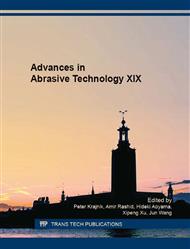[1]
X.F. Chen, X. G. Xu, X.B. Hu, Anisotropy of chemical mechanical polishing in silicon carbide substrates. Mater. Sci. Eng., B 142 (2007) 28-30.
Google Scholar
[2]
A. Venu Gopal, P. Venkateswara Rao, A new chip-thickness model for performance assessment of silicon carbide grinding. Int. J. Adv. Manuf. Technol. 24 (2004) 816-820.
DOI: 10.1007/s00170-003-1788-6
Google Scholar
[3]
Y. Zhou, G.S. Pan, X.L. Shi. Chemical mechanical planarization (CMP) of on-axis Si-face SiC wafer using catalyst nanoparticles in slurry. Surf. Coat. Tech. 251 (2014) 48-55.
DOI: 10.1016/j.surfcoat.2014.03.044
Google Scholar
[4]
H. Aida, T. Doi, H. Takeda . Ultraprecision CMP for sapphire, GaN, and SiC for advanced optoelectronics materials. Curr. Appl. Phys. 12 (2012) 41-46.
DOI: 10.1016/j.cap.2012.02.016
Google Scholar
[5]
C.L. Nelson, W.C. Mitchel, R.L. Hengehold, Effects of process parameter variations on the removal rate in chemical mechanical polishing of 4H-SiC, J. Electron. Mater. 30 (2001) 1271-1275.
DOI: 10.1007/s11664-001-0111-2
Google Scholar
[6]
L. Zhou, V. Audurier, P. Pirouz, et al, Chemomechanical polishing of silicon carbide, J. Electron. Soc. 144 (1994) 161-163.
Google Scholar
[7]
W. Qian, M. Skowronski, G. Augustine, et al, Characterization of polishing related surface damage in (0001) silicon carbide substrates. Electrochem. Soc. 142 (1995) 4290-4294.
DOI: 10.1149/1.2048499
Google Scholar
[8]
C.H. Li, I. B. Bhat, R.J. Wang, et al,Electro-chemical mechanical polishing of silicon carbide, J. Electron Mater., 33 (2004) 481-486.
Google Scholar
[9]
F. J Wang, Z.D. Wang, Z.Q. Yang, Study on technique of magnetorheological finishing single crystal silicon carbide. Science and Technology Innovation Herald, 32 (2010) 112-113.
Google Scholar
[10]
Z. Z Zhu, V. Murator, Tribochemical polishing of silicon carbide in oxidant solution, Wear, 225-229 (1999) 848-856.
DOI: 10.1016/s0043-1648(98)00392-5
Google Scholar
[11]
K. Yamamura, T. Takiguchi, M. Ueda, et al. Plasma assisted polishing of single crystal SiC for obtaining atomically flat strain-free surface, CIRP Ann-Manuf Techn. 60 (2011) 571-574.
DOI: 10.1016/j.cirp.2011.03.072
Google Scholar
[12]
H. Deng, K. Endo, K. Yamamura. Damage-free and atomically-flat finishing of single crystal SiC by combination of oxidation and soft abrasive polishing. Procedia CIRP 13 ( 2014 ) 203-207.
DOI: 10.1016/j.procir.2014.04.035
Google Scholar
[13]
H. Deng, K. Yamamura. Smoothing of reaction sintered silicon carbide using plasma assisted polishing, Curr. Appl. Phys. 12 (2012) 24-28.
DOI: 10.1016/j.cap.2012.04.004
Google Scholar
[14]
W.L. Chou, C.T. Wang, W.C. Chang, et al. Adsorption treatment of oxide chemical mechanical polishing wastewater from a semiconductor manufacturing plant by electrocoagulation, J. Hazard Mater., 180 (2010) 217-224.
DOI: 10.1016/j.jhazmat.2010.04.017
Google Scholar
[15]
C.Y. Hu, S.L. Lo, C.M. Li, et al. Treating chemical mechanical polishing (CMP) wastewater by electro-coagulation-flotation process with surfactant. J. Hazard Mater. , 20 (2005) 15-20.
DOI: 10.1016/j.jhazmat.2004.12.038
Google Scholar


